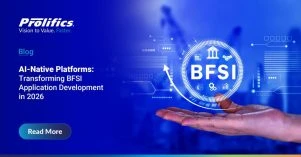Complex physical workflows
In any complex physical workflow process, such as assembling an engine, maintaining or repairing a machine, or quality inspecting mechanisms or instruments, there are two things happening:
- The operator is interacting with the complex process in a real, physical environment
- The operator needs a high level of knowledge of the process and an understanding of the physical environment
Since the process is, in fact, complex, an operator will need additional information to complete the task. This information usually comes in the form of:
- A manual that’s perhaps hundreds of pages long
- Just “figuring it out” themselves
- Asking someone else
Any of these information forms are problematic; they can lead to delays, inefficiencies, mistakes and reworks – costing the process owners time and money.
New technologies and the connected worker
Prolifics has taken new technologies, each powerful in their own right, and combined them into a very evolved, live digital system that connects and integrates the operator with the complex workflow, helping the worker continuously address – in real time – whatever challenges arise. These layers of value are made up of:
- Augmented/mixed reality wearables – these headsets provide the view into reality with a digital overlay. For example, it could display a schematic of the machine an operator is repairing, or a parts list for the engine the operator is building. Wearables actually increase safety, as the headsets free the operator’s hands from manuals, tablets or other information-providing handhelds.
- Artificial intelligence (AI) computer vision – is one channel of insight into understanding the physical environment and assisting the operator through it. It interprets the environment using computer vision, and then uses AI to understand what the operator is looking at and pull the right information.
- Generative pre-trained transformers (GPT) – creates the ability in an application to generate human-like text and have discussions or answer questions in a human-like, conversational way, as well as generate content like images.
Combining these technologies together in effect creates a “live digital assistant,” a form that passes the exactly needed information to the operator, in real time, as the operator works with the complex process. These technologies don’t replace the worker – they greatly enhance the operator’s ability to perform their job.
Scenario
The quality inspection of a machine requires a human/manual component – it requires the deductive logic of human beings. And while your quality inspectors (operators) must adhere to documented specifications, there is always the possibility of subjectivity – any one particular operator may have a different way of interpreting situations or assessing certain defects.
The quality inspection is usually a sequence of steps that the operator needs to perform, and with each step there would be a sequence of activities. The mixed reality system would provide these sequences to the operator, either visually or audibly. The AI computer vision knows at all times what the operator is looking at, and can provide a 3D, holographic arrow to point the operator to the right place. The AI computer vision could also detect defects that the operator either could not see or perhaps missed, and then GPT would provide an analysis with instructional details for a suggested resolution.
The technologies of the connected worker help your operators locate defects better and help them conduct inspections faster and more precisely as a whole. It removes some of the subjectivity, raising the consistency value of all the inspections as well. The connected worker brings greater speed, better precision and higher consistency to this quality inspection.
More on this Prolifics offering – Industrial Metaverse and Connected Worker Experiences
The “Industrial Metaverse” is the deep integration of information, communication, and the real economy. The same is true for the “Connected Worker.” The ultimate goal is to build a new, efficient industrial system, both manufacturing and service, across the whole value chain.
- Internet of Things (IoT) – IoT represents physical devices connected globally through the internet, all modified with sensors, software, processing abilities, and other tech so they can exchange data among devices and systems.
- Digital twin – This is the digital representation of an actual physical product, system, or process. The “twin” serves as an exact digital counterpart to run simulations on integration, monitoring, and maintenance.
- Virtual and augmented reality (mixed reality) – Virtual reality (VR) provides near real experiences in a virtual way, while augmented reality (AR) enhances the real world by superimposing computer-generated information on top of it. Both use specialized headset equipment, though a less immersive experience is available over normal devices.
- AI computer vision – With equipment or in manufacturing, it provides analytics that can uncover nuanced issues undetectable through traditional quantitative data. This can predict failure earlier and prescribe steps to extend the useful life.
Visit our Emerging Technologies Webpage!
About Prolifics
At Prolifics, the work we do with our clients matters. Whether it’s literally keeping the lights on for thousands of families, improving access to medical care, helping prevent worldwide fraud or protecting the integrity and speed of supply chains, innovation and automation are significant parts of our culture. While our competitors are throwing more bodies at a project, we are applying automation to manage costs, reduce errors and deliver your results faster.
Let’s accelerate your transformation journeys throughout the digital environment – Data & AI, Integration & Applications, Business Automation, DevXOps, Test Automation, and Cybersecurity. We treat our digital deliverables like a customized product – using agile practices to deliver immediate and ongoing increases in value. Visit prolifics.com.




